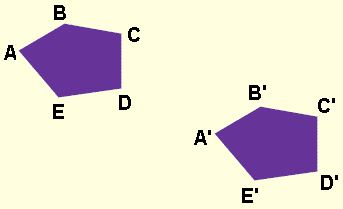Intuitive Notion of Translations
A translation “slides” an object a fixed distance in a given direction. The original object and its translation have the same shape and size, and they face in the same direction.
The word “translate” in Latin means “carried across”.
When you are sliding down a water slide, you are experiencing a translation. Your body is moving a given distance (the length of the slide) in a given direction. You do not change your size, shape or the direction in which you are facing.
 Translations can be seen in architectural design. The stadium seats in this photograph are the same size and shape and face in the same direction.
Translations can be seen in architectural design. The stadium seats in this photograph are the same size and shape and face in the same direction.
 Musicians utilize translations when they compose musical scores. Certain patterns of musical notes are often repeated within a composition. Think of songs you know where a certain tune repeats itself within the song (perhaps in a different octave).
Musicians utilize translations when they compose musical scores. Certain patterns of musical notes are often repeated within a composition. Think of songs you know where a certain tune repeats itself within the song (perhaps in a different octave).
 Translations can be found in nature. This photograph shows a microscopic view of the scales of a butterfly.
Translations can be found in nature. This photograph shows a microscopic view of the scales of a butterfly.
 In mathematics, the translation of an object is called its image. If the original object was labeled with letters, such as polygon ABCDE, the image may be labeled with the same letters followed by a prime symbol, A’B’C’D’E’.
In mathematics, the translation of an object is called its image. If the original object was labeled with letters, such as polygon ABCDE, the image may be labeled with the same letters followed by a prime symbol, A’B’C’D’E’.
 Think of polygon ABCDE as sliding two inches to the right and one inch down. Its new position is labeled A’B’C’D’E’.
Think of polygon ABCDE as sliding two inches to the right and one inch down. Its new position is labeled A’B’C’D’E’.
A translation moves an object without changing its size or shape and without turning it or flipping it.